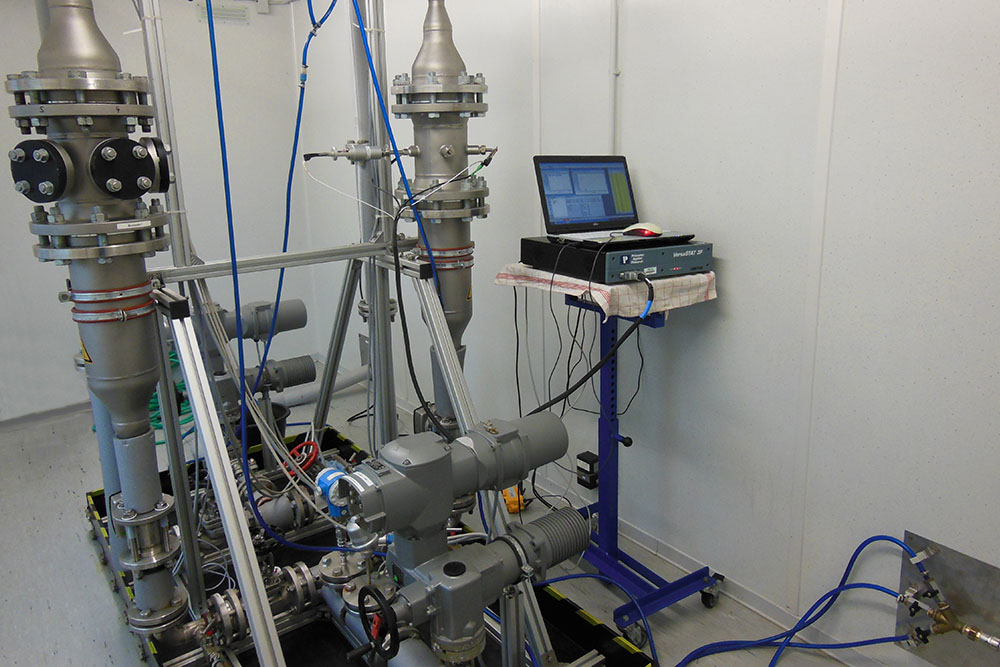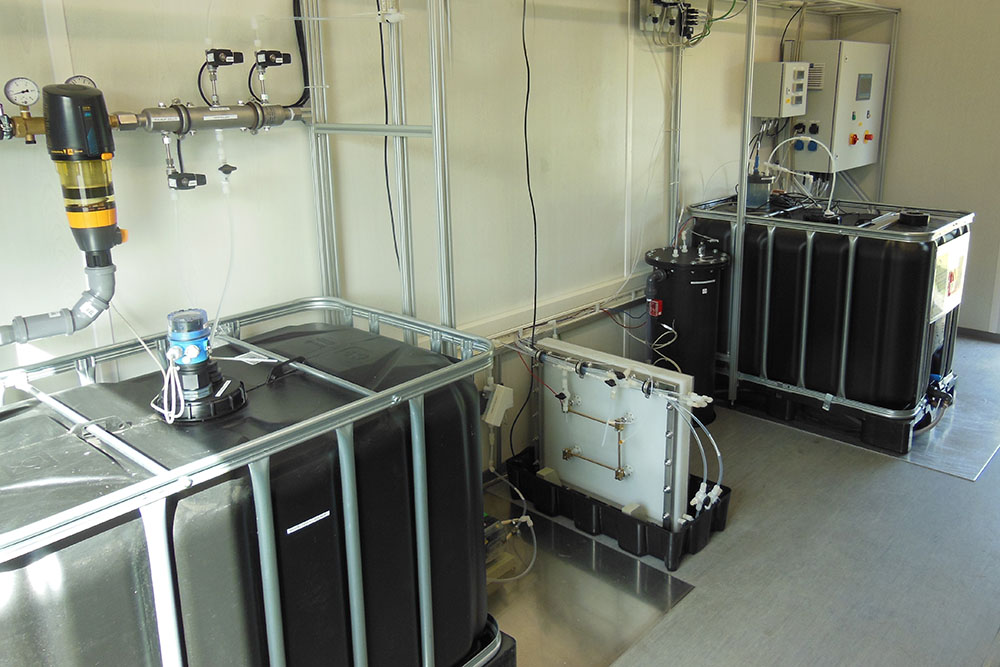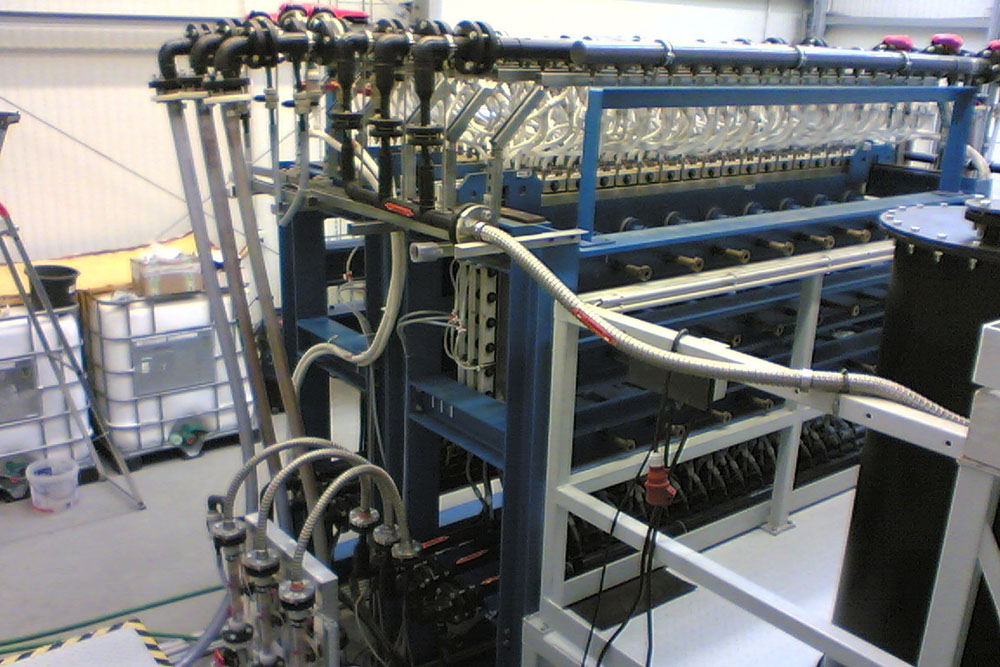Application centers for electrochemical water treatment: Using wastewater as a resource
With the right purification and treatment technologies, wastewater can be a valuable resource: whether for thermal energy, strategic raw materials or treated as valuable drinking or industrial water. Our application centers for electrochemical water treatment show how this can work. Spread over five locations, Fraunhofer IKTS develops, analyzes and tests new ways to acidic water and closed material cycles.
Geothermal power plant Neustadt-Glewe
In Neustadt-Glewe in Mecklenburg-Western Pomerania, 90 °C hot water is pumped from a depth of more than 2400 m, supplying the town, several businesses, and nurseries with heat. This is where Fraunhofer IKTS operates a deep geothermal test bed and works on solutions to mitigate undesirable side effects, such as corrosion and radioactive deposits, and possibly even turn them into benefits. All these tests are intended to contribute to a broader and safer use of heat extraction from the earth.
When thermal brines are extracted, heavy metals, trace elements and naturally occurring radio-nuclides deposit on critical plant components. For example, they cause corrosive damage to pipes, pumps, valves, and heat exchangers, which could lead to major downtime. Among other things, the scientists are looking for special coatings and materials on which few deposits form and which can withstand the aggressive hot water better than normal steel. They are also working on conditioning the thermal brines using electrochemical water treatment processes. Unique in Germany is the galvanic in-situ separation of radioactive lead, arsenic, and usable trace metals. At the same time, processes for the utilization of dissolved main components such as sodium chloride are also being researched. The knowledge gained has been used in the design of numerous geothermal plants.
Waterworks Brüel
In Brüel near Güstrow, bentazone and other herbicides from agriculture pollute the well water of a waterworks. Fraunhofer IKTS has installed test systems with different purification processes in the waterworks there and operated them on a pilot scale with a purification capacity of 50 to 100 l/h over a longer period of time. This enables us to evaluate different purification processes against each other in terms of effectiveness, costs, and reliability. With electrochemical total oxidation, for example, not only can the herbicides be removed without costly preconditioning of the well water, but at the same time aluminum, iron and manganese can be separated down to traces and the pH value stabilized. This allows the water to be used again as drinking water. Currently, there are considerations to further expand this application center.

Rainitza mine water treatment plant
The groundwater from former opencast lignite mines is contaminated with iron, manganese, sulfates, and other substances. Near Großräschen at the Rainitza region, Fraunhofer IKTS has a 1000 m² test site with the corresponding technical infrastructure. Various test campaigns can be carried out on a pilot scale at a volume flow of up to 10 m³/h. The tests range from the testing of different types of water treatment systems to the development of a new water treatment system. These range from the testing of different electrochemical water treatment processes and their combination to the treatment of different types of mining water and the treatment of very heavily polluted water, including economic evaluation.
For example, large electrolysis cells separate sulfate from mine water, which can then be processed into fertilizer products, and aluminum, iron, manganese, and nickel are dissolved out. Additional carbon dioxide further reduces the sulfate load, producing lime as a byproduct.
Tin mine Ehrenfriedersdorf
In order to also offer pilot tests at an underground test site in the future, Fraunhofer IKTS is currently building a new Application Center in a former tin ore mine in Ehrenfriedersdorf. For this purpose, various plant modules are being installed in the mine system and tested under real conditions. The aim is to use various technological methods to process large volumes of contaminated mine water into service water. In addition, the researchers are evaluating how valuable substances can be extracted economically from mine water in order to use them, for example, as a basic material for the metal or glass industry, as a fertilizer for agriculture or as a strategic raw material for power electronics and e-mobility. In addition, it is also possible in this Application Center to test how processes can be made more efficient with Industry 4.0 technologies.
Wastewater treatment plant Bitterfeld-Wolfen
At the Bitterfeld-Wolfen Chemical Park, various types of industrial wastewater are produced, for example from the chemical, plastics and pharmaceutical industries. In the coming months, Fraunhofer IKTS will gradually erect test containers with various pilot plants for electrodialysis, electrochemical total oxidation, membrane distillation and membrane extraction at the chemical park's municipal wastewater treatment plant. These individual technology platforms are to be so cleverly interconnected that pollutants can be destroyed, high salt loads separated, valuable substances efficiently recovered and material cycles closed. In view of stricter water quality criteria, this meets the need for better treatment methods for industrial wastewater and offers an economically viable solution for recovering valuable substances from wastewater in the face of continuously rising raw material prices.
Further information
Stay informed: You are welcome to subscribe to our newsletter, read our other blog articles and follow us on LinkedIn, Instagram and YouTube.

